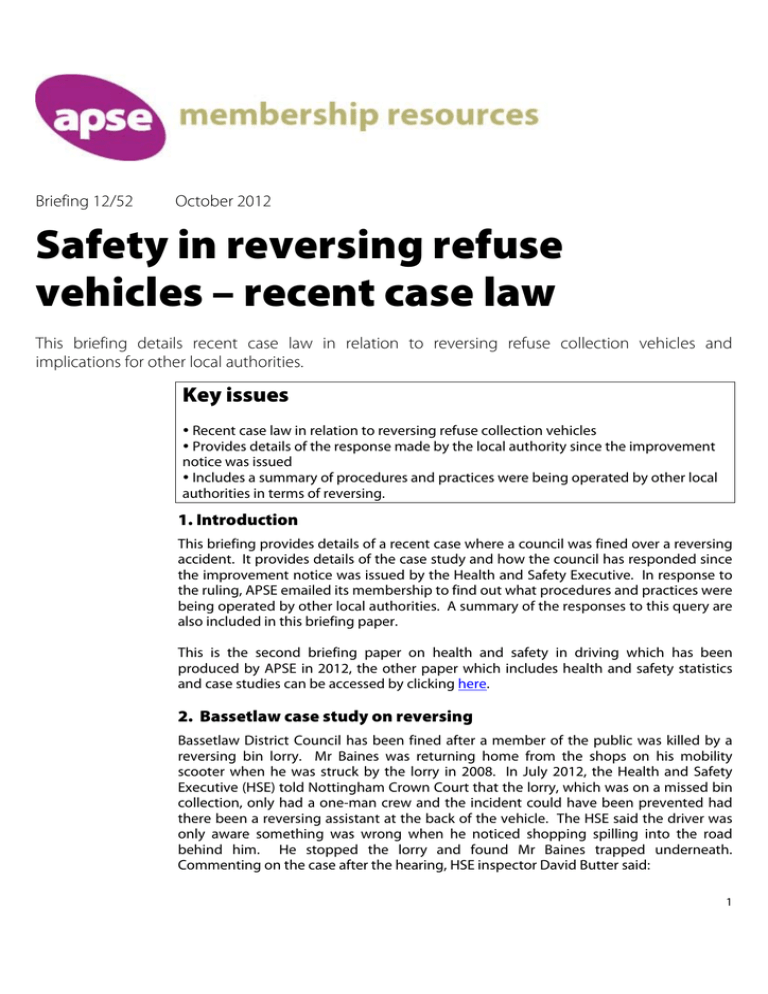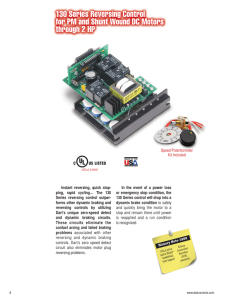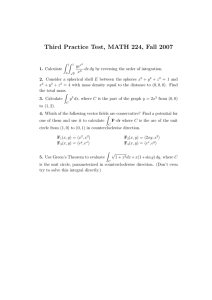Safety in reversing refuse vehicles – recent case law
advertisement

Briefing 12/52 October 2012 Safety in reversing refuse vehicles – recent case law This briefing details recent case law in relation to reversing refuse collection vehicles and implications for other local authorities. Key issues Recent case law in relation to reversing refuse collection vehicles Provides details of the response made by the local authority since the improvement notice was issued Includes a summary of procedures and practices were being operated by other local authorities in terms of reversing. 1. Introduction This briefing provides details of a recent case where a council was fined over a reversing accident. It provides details of the case study and how the council has responded since the improvement notice was issued by the Health and Safety Executive. In response to the ruling, APSE emailed its membership to find out what procedures and practices were being operated by other local authorities. A summary of the responses to this query are also included in this briefing paper. This is the second briefing paper on health and safety in driving which has been produced by APSE in 2012, the other paper which includes health and safety statistics and case studies can be accessed by clicking here. 2. Bassetlaw case study on reversing Bassetlaw District Council has been fined after a member of the public was killed by a reversing bin lorry. Mr Baines was returning home from the shops on his mobility scooter when he was struck by the lorry in 2008. In July 2012, the Health and Safety Executive (HSE) told Nottingham Crown Court that the lorry, which was on a missed bin collection, only had a one-man crew and the incident could have been prevented had there been a reversing assistant at the back of the vehicle. The HSE said the driver was only aware something was wrong when he noticed shopping spilling into the road behind him. He stopped the lorry and found Mr Baines trapped underneath. Commenting on the case after the hearing, HSE inspector David Butter said: 1 “If the council had staffed the refuse collection lorry appropriately then Mr Baines would probably still be alive today. Very large vehicles such as this have a number of blind spots and it was impractical to expect a lone driver to reverse safely without the aid of a colleague walking behind to check the path was clear…These lorries are fitted with flashing lights and a reversing warning system but the council needed to take into consideration that system was not adequate and another worker should have been present and could have prevented this needless loss of life.” Bassetlaw District Council pleaded guilty breaching Section 3(1) of the Health and Safety at Work etc Act 1974. Nottingham Crown Court fined the council £25,000 and ordered it to pay costs of £12,987. APSE contacted Bassetlaw District Council to inform this paper to assist other councils in how they have responded to this accident. Their response is included in section 3 below. 3. Response from Bassetlaw council At the time of this very regrettable accident Bassetlaw District Council’s Refuse Collection Service operated within its own recognised systems of work which had been in place for some time. This system of work was only amended as necessary where the Councils risk assessment process highlighted that change was necessary. To ensure that the system of work was effective it was supported by a Drivers Handbook, Code of Safe Working Practice and provision of Health and Safety training for drivers and loaders. The accident happened on the missed bin collection round. At the time of the accident Government performance indicators were imposed on refuse collection services, one of which was that missed bin reports should be collected within 24 hours of the report. This indicator is now voluntary however the Council still aims for this target. On the day of the accident there was no reversing assistant available to accompany the driver on his missed bins collection. He proceeded on his own, in a 26 tonne refuse collection vehicle as was permitted at that time, so long as the driver applied risk assessment principles to determine if any manoeuvre was safe to carry out. During the prosecution hearing this was considered by the prosecutors to be the “single point of weakness” in our system. The judgement in the case demonstrates that despite operating a modern, well maintained fleet of vehicles equipped with a range of reversing aids and alarms, it is not considered sufficiently safe to allow a well-trained driver to reverse in the way that ours was on the day of the accident. What we have changed since the Improvement Notice was issued by the HSE required a significant level of resourcing. Co-operation between the Health and Safety Advisers, Transport and Operational Refuse Managers was essential to ensure the operation as a whole could progress. Procedural changes include: 1) Developing and introducing Rounds Risk Assessments (RRA) looking particularly at the reverse manoeuvres. This consisted of identifying 3 main risks arising from reversing refuse vehicles (vehicles striking pedestrians, striking other vehicles / structures and loaders being struck by vehicles). The level of risk at every reverse location was then calculated using factors such as road speed limits, vulnerable residents, traffic flow rates, 2 1 or 2 sided collection etc. 51 rounds were assessed resulting in changes to 10 rounds (e.g. re-route to avoid reverse, change times of collection at schools etc. to minimise risk). 2) An updated generic risk assessment was carried out including Hepatitis B vaccination, PPE, Landfill site procedures, lift mechanism safety etc. and created more detailed Manual Handling Risk Assessments. 3) Both the Driver/Loader and Management manuals were updated and re-issued to all relevant staff members with instructions on the need to comply. 4) Following more detailed assessment it was established that the missed bins collection will be by 2 operators wherever resources permit (Driver and Reversing Assistant) or 1 man operator using smaller sidewinder vehicle which is non-HGV. 5) The risk assessment concluded that the Rural Collection Round could still operate safely as a 1 person round. Training & communication 1) All Loaders are trained as Reversing Assistants. 2) Charge hands are now also trained to Train the Trainer Standard through ROSPA to cascade and deliver refresher reversing assistant training to employees and new starters. 3) Practical Manual Handling Training. Although not directly related to the accident, ‘task specific’ manual handling training is provided to all Loaders and repeated every 2 years. Monitoring 1) A ‘Rounds Audit’ has been produced and included on our online safety management system. Every round is formally audited 4 times per year by Managers. Additional ad hoc audits are carried out. Vehicle standards 1) We have retro fitted LED flashing lights to the rear of the vehicles. 2) We are currently trialling 360º cameras on the one man refuse round and road sweeper (this captures live recordable data). 3) We are currently investigating the usefulness and implications of installing the ‘In Cab Route Information System’ with a view to including this on the vehicle specification for future fleet purchases. 4. Commentary In response to the ruling, APSE emailed its membership to find out what procedures and practices were being operated by other local authorities throughout the UK. The full responses are available to APSE member authorities by emailing djohns@apse.org.uk. 28 responses were received to the query and a summary of the key findings are shown below: 3 Question 1: Do you employ a designated reversing assistant for all of your refuse collection rounds? There was a mix of responses to this question; some authorities are reviewing their current procedures and introducing designated reversing assistants for all of their rounds. In addition, some councils are now introducing training for this in inductions. Most commented that all refuse staff are trained as banksmen/reversing assistants or reversing ‘lookouts’. Question 2: What size is your crew (e.g. driver+ 1)? The majority of respondents operate a driver plus 2 system for domestic refuse collections. The size of the crew within some local authorities varies according to type of location (urban/rural) and type of collection (domestic/trade/recycling). Question 3: What safety measures are built into vehicles e.g. lights/warning systems? Responses to this question included: Rear view/reversing cameras and mirrors 360 degree camera systems that record what happens around the vehicle Visual and audible warning system/reversing alarm Sensor detection/braking systems and banksman radar/system Reversing lights, beacons and spotlights for working at the back of the vehicle Driver ID (which prevents unauthorised driving) Route warnings via in-cab system Question 4: Do you have training that incorporates reversing and if so, who delivers it? The majority of respondents deliver training in-house by supervisors (where some have been on train the trainer courses), health and safety trainers, internal training providers or technical assistants. The training varies between driver training, banksmen training, reversing/reversing assistant training and waste and recycling operative courses. Some respondents commented that this includes induction training which is refreshed or repeated at regular intervals and other councils have procedures for remedial training where there have been reversing incidents. Question 5: Do your Risk Assessments/Safe Systems of Work incorporate reversing? All respondents answered that their risk assessments/safe systems of work incorporate reversing or that they are in the process of carrying out route specific risk assessments which include areas where it is necessary to reverse. One council stated that they have a Reversing Policy and another commented that reversing is included in their staff handbook and toolbox talks. This initial survey shows that there is a range of good practice measures being employed by different councils throughout the UK and APSE would urge its members to review their policies and practices in light of these recent developments. The Health and Safety Executive (HSE) website hosts a range of guides and materials which members may find helpful including Waste and recycling vehicles in street collection good practice document (click here) and transport movements (click here). 4 The HSE identify the following main considerations for preventing transport-related accidents in pedestrian environments: Carrying out a route risk assessment to highlights major hazards on the route(s) and indicate how they may be avoided or the risks minimised, for example, arranging collections to avoid certain times of the day in sensitive areas (e.g. start, finish and lunch times for schools); Identify those areas where it is reasonably practicable to carry out single-sided street collection in order to minimise the risks of refuse collectors crossing the road; Safe reversing and use of reversing assistants. The risks associated with reversing vehicles can be reduced by: eliminating or reducing reversing manoeuvres wherever possible; devising and following safe systems of work; using reversing aids such as mirrors, CCTV, detectors and alarms; using trained reversing assistants only when the risks cannot be adequately controlled by the above; and monitoring work activities from time to time to ensure that the agreed system of work is being implemented. Source: Health and Safety Executive website APSE will be featuring a presentation by the Health and Safety Executive on ‘HSE Interventions with Local Authority Waste and Recycling Services’ at its forthcoming APSE environmental services annual conference on 7-8 November 2012. Please click here to view the whole programme. If your council would like APSE to deliver specific training on any of the above health and safety issues to your managers, supervisors or staff, then please email jkennedy@apse.org.uk and provide details of your requirements. Debbie Johns Principal Advisor 5



